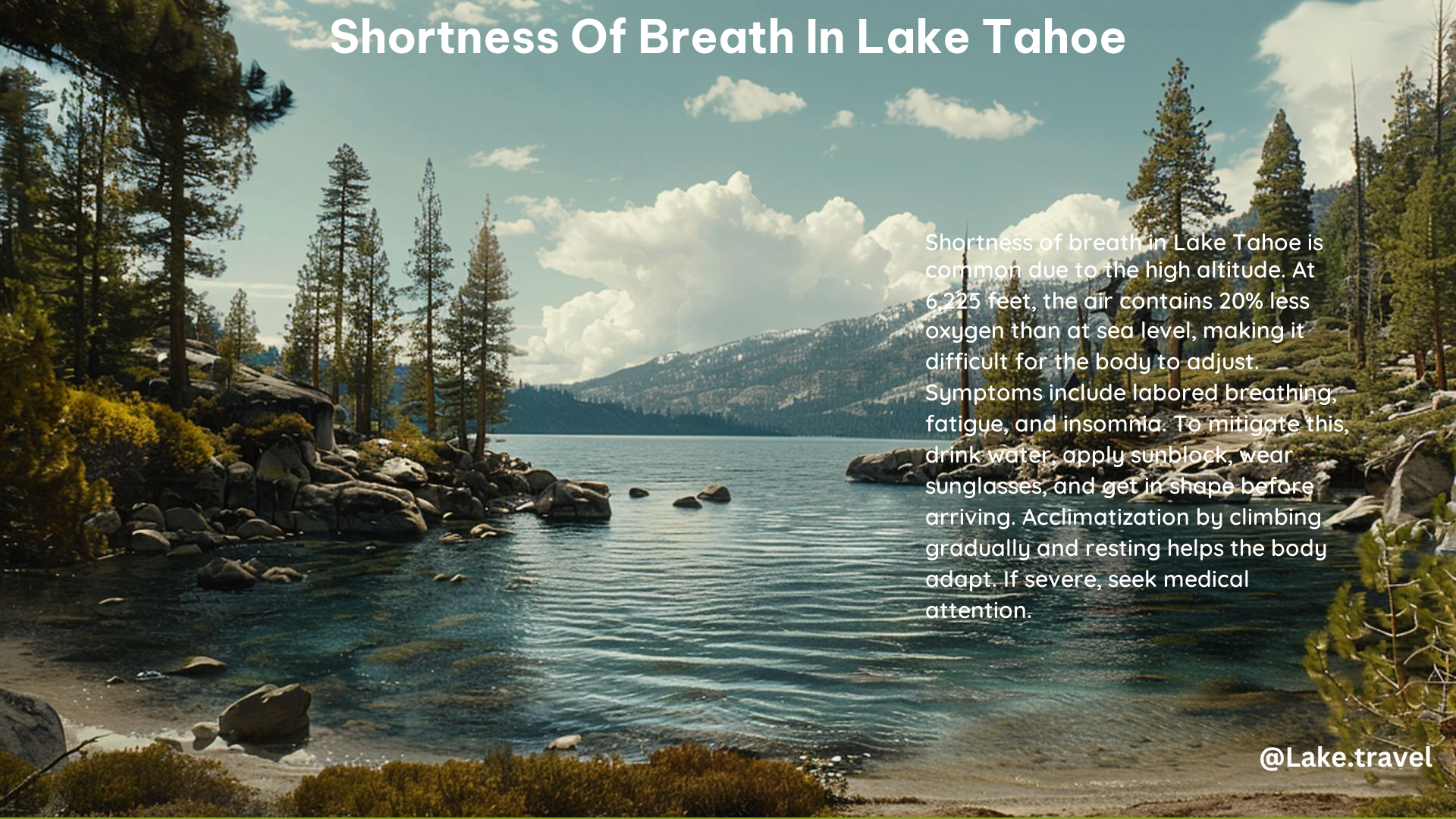Visiting the stunning Lake Tahoe region can be an exhilarating experience, but for many travelers, the high altitude can lead to a common issue – shortness of breath. As a Lakes Touring Enthusiast, understanding the causes and solutions for this problem can help you make the most of your time in this breathtaking destination.
Why Do I Experience Shortness of Breath in Lake Tahoe?
The primary reason for experiencing shortness of breath in Lake Tahoe is the high elevation. Situated at an average elevation of 6,225 feet above sea level, the air in this region contains approximately 20% less oxygen than at sea level. This reduction in oxygen availability can lead to a condition known as altitude sickness, or acute mountain sickness, which can cause a range of symptoms, including shortness of breath.
Altitude Sickness
Altitude sickness occurs when the body is unable to adjust quickly enough to the lower oxygen levels at higher elevations. This can happen even in relatively fit individuals, as the physiological changes required to adapt to the thinner air take time. The reduced oxygen levels can cause the body to produce more red blood cells to compensate, but this process takes several days to complete, leading to breathing difficulties in the meantime.
Physiological Changes
In addition to the reduced oxygen levels, the body undergoes other physiological changes at high altitudes that can contribute to shortness of breath. The air pressure is lower, which can make it more difficult for the lungs to expand and take in the same volume of air as at lower elevations. The dry air can also cause the airways to become irritated and inflamed, further exacerbating breathing problems.
What Can I Do to Alleviate Shortness of Breath During My Visit to Lake Tahoe?

Fortunately, there are several steps you can take to help alleviate the effects of the high altitude and minimize your experience of shortness of breath during your visit to Lake Tahoe.
Acclimatization
One of the most effective ways to combat altitude sickness and shortness of breath is to gradually acclimate to the higher elevation. This means slowly ascending to higher altitudes, rather than immediately jumping to the full elevation of your destination. By allowing your body time to adjust, you can help it adapt to the lower oxygen levels and reduce the severity of your symptoms.
Hydration
Staying well-hydrated is crucial when visiting high-altitude destinations like Lake Tahoe. The dry air can quickly lead to dehydration, which can exacerbate the effects of altitude sickness and contribute to shortness of breath. Make sure to drink plenty of water throughout the day, and avoid alcohol and caffeine, which can further dehydrate you.
Pacing and Rest
When exploring Lake Tahoe, it’s important to take it easy and listen to your body. Avoid strenuous activities, especially in the first few days of your visit, and be sure to take frequent breaks to rest and recover. This will help your body adjust to the altitude and minimize the impact on your breathing.
Oxygen Supplements
If your symptoms of shortness of breath are severe or persistent, you may want to consider using supplemental oxygen. Many businesses in the Lake Tahoe area, such as oxygen bars, offer oxygen therapy to help visitors cope with the high altitude. Consulting a local healthcare provider can also provide guidance on the use of medications or other treatments to alleviate altitude sickness and breathing difficulties.
Additional Tips for Visiting Lake Tahoe
In addition to the strategies for managing shortness of breath, there are a few other tips to keep in mind when visiting Lake Tahoe:
-
Dress Appropriately: The weather in Lake Tahoe can be unpredictable, with significant temperature fluctuations throughout the day. Wear breathable, layered clothing to help you adjust to the changing conditions.
-
Protect Yourself from the Sun: The high altitude means the sun’s UV rays are more intense. Be sure to apply sunscreen and wear a hat or sunglasses to protect your skin and eyes.
-
Listen to Your Body: If you start to feel unwell or experience severe symptoms, don’t hesitate to rest, hydrate, or seek medical attention. It’s better to take it slow and enjoy your time in Lake Tahoe than to push yourself too hard and risk your health.
By understanding the causes of shortness of breath in Lake Tahoe and following these tips, you can better prepare for and manage this common high-altitude challenge. Enjoy your time in this stunning natural wonder while prioritizing your health and well-being.
References
- Zaca Life. (n.d.). 3 Tips To Prevent Lake Tahoe Altitude Sickness. Retrieved from https://zacalife.com/blogs/blog/3-tips-to-prevent-lake-tahoe-altitude-sickness
- Tahoe Daily Tribune. (2001, December 19). Life at high altitude has its ups and downs. Retrieved from https://www.tahoedailytribune.com/news/life-at-high-altitude-has-its-ups-and-downs/
- TripAdvisor. (2022, July 4). Altitude Concern – Lake Tahoe (California) Forum. Retrieved from https://www.tripadvisor.com/ShowTopic-g155987-i338-k14016202-Altitude_Concern-Lake_Tahoe_California_California.html
- Tahoe Dave’s. (2013, April 23). Is Lake Tahoe Leaving You Breathless? Here’s Some High Altitude Health Tips. Retrieved from https://tahoedaves.com/is-lake-tahoe-leaving-you-breathless-heres-some-high-altitude-health-tips/
- Oxygen Bar Tahoe. (n.d.). Altitude Sickness/Elevation Sickness. Retrieved from https://www.oxygenbartahoe.com/altitude-elevation-wellness
